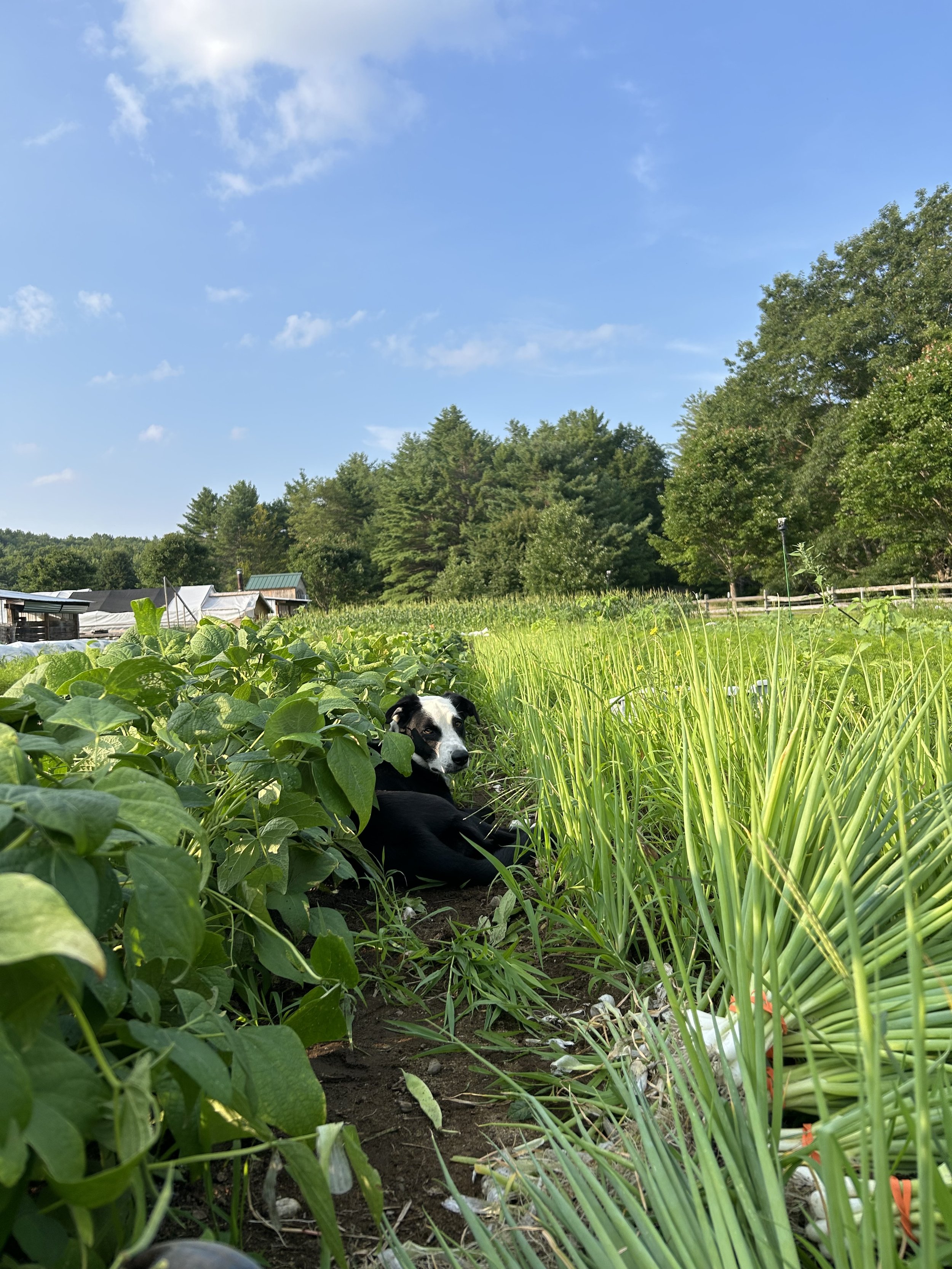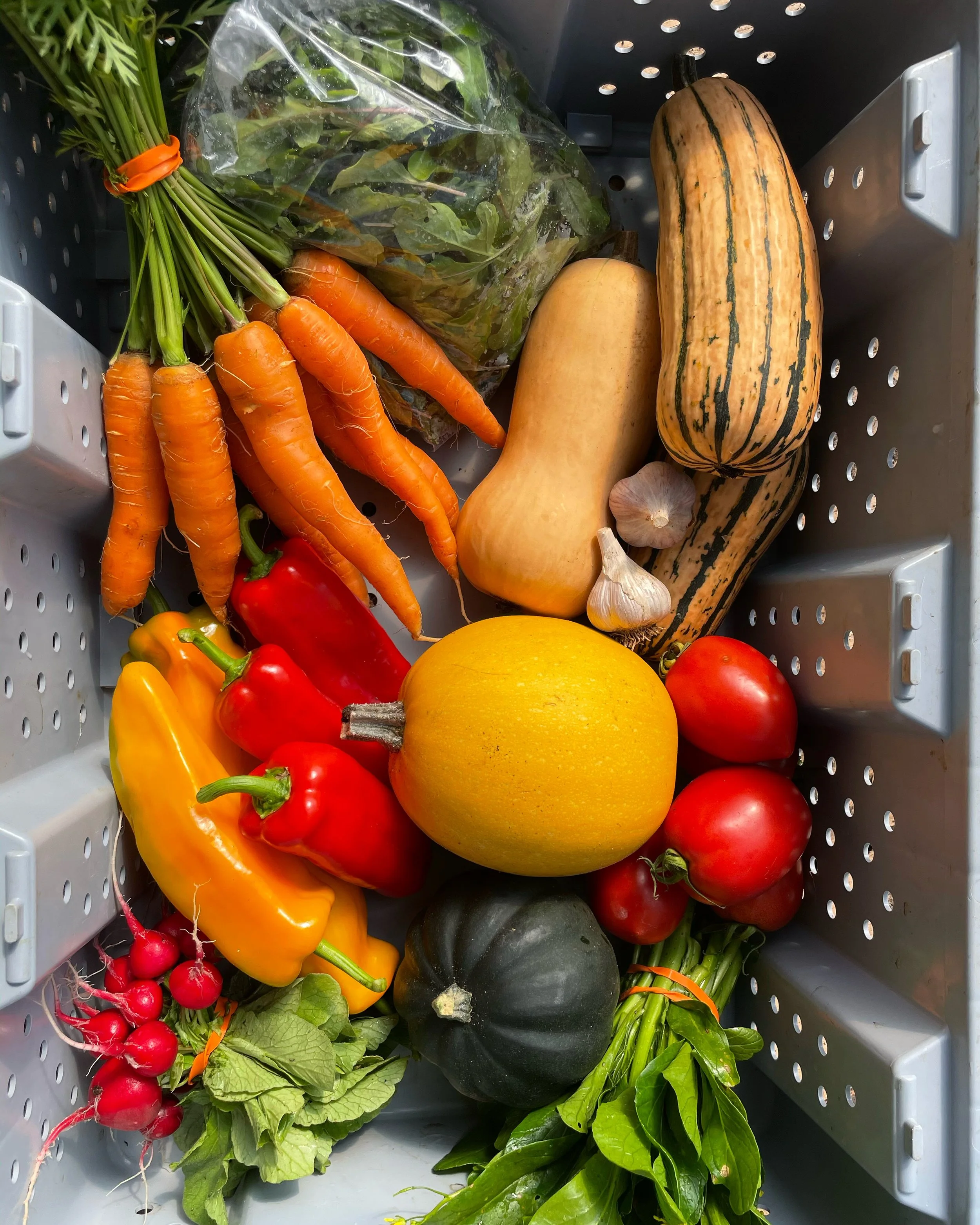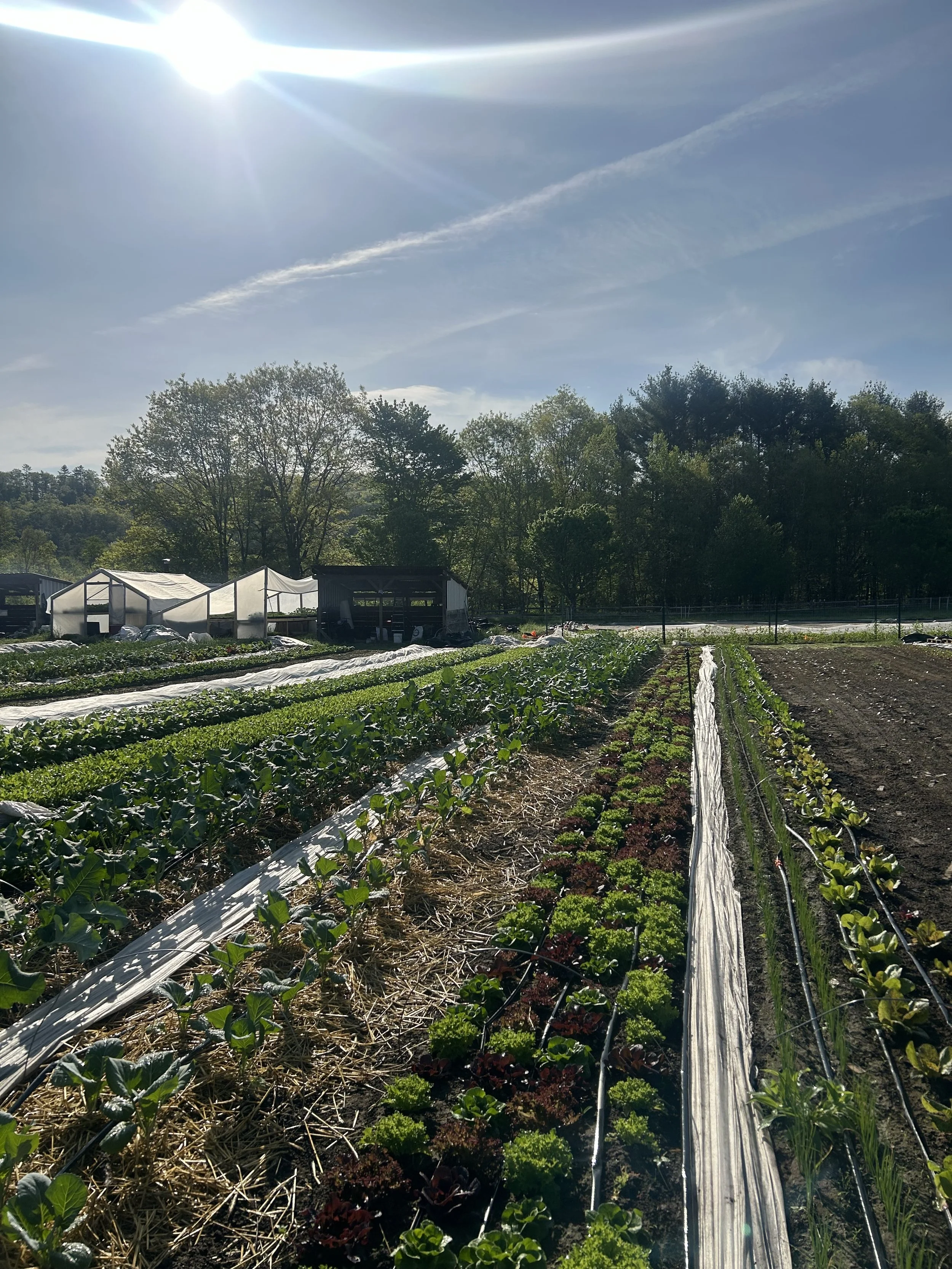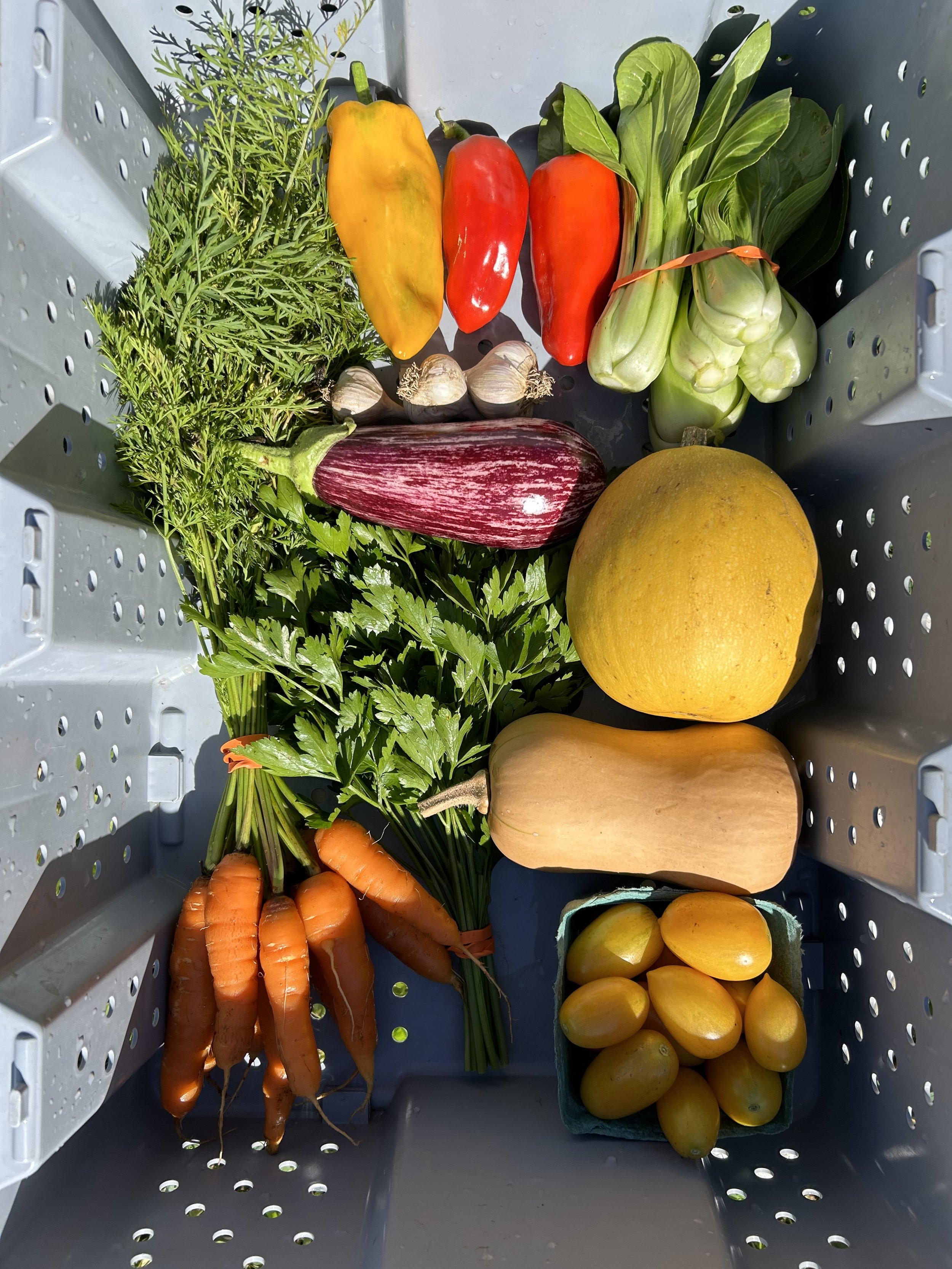2 Reasons Why You Should Join A CSA in 2025 (even if it’s not ours)
It’s snowing… again. The farm is totally buried and summer feels a long ways away.
Not a problem for Vesper!
“Thank you for bringing me skiing. I’m tired now”
I’m telling you – This is her Olympics
But the days are getting longer, the sun is gaining strength, and we are less than a month away from firing up the propagation greenhouse for our first round of seeding.
Then we’re off, launched into another season. A couple months and our monochromatic snowscape will feel like a distant memory. I’m starting to get excited… Vesper, less so.
“can we be done now”
Still gotta get bok choy, sorry Vesper
And Romano beans
Now gotta wash it all…
“Missing something?”
Ok, ok, now that we’re all stoked for warmer weather I’m gonna do a little shameless promotion of our 2025 CSA (and local regenerative ag as a whole).
I could think of a hundred reasons why you should join our CSA this year but I’ll keep it brief and condense it all down to two categories: sustainability and price.
Sustainability
Head lettuce interplanted with peas. This method helps minimize exposed soil, maximize yield per bed foot, and creates a cooler environment for the lettuce.
Not to be all doom and gloom, but the food system is a bit of mess right now. And I am honestly concerned.
It’s like a Jenga tower near the end of the game: it got really big really fast and was built by people who don’t know the first thing about architecture.
I’m not talking about farmers – it’s political alliances and corporate interests that have shaped the way we produce, distribute, and consume food. And they don’t seem to have us in mind. They’re playing for money.
Our precarious tower is held up like a puppet by government subsidies, synthetic chemicals, and a finite amount of topsoil that is being degraded at an alarming rate. At its foundation are everyday consumers, truck drivers, grocery store workers, farm laborers (many of whom are undocumented – it is estimated over 50% in California).
In the past few weeks alone, the current administration has yanked out some key Jenga blocks with no regard for the humanity of the people affected. These actions have sent shooting cracks through the foundation of our food system and left it teetering wildly.
Critical aid for farmers and low-income consumers is in jeopardy. Mass deportations and ICE raids have left fields to rot and families in peril. Not-so conveniently timed, avian influenza outbreaks have lead to the death of hundreds of millions of birds, causing egg prices to skyrocket. And it’s looking like food prices will only continue to rise. In a country where minimum wage cannot feed a family, this is a crisis. We gotta do something!
But who is “we”? Would’t it be nice if government officials and large corporations would enact sweeping change to help struggling Americans make ends meet? Maybe they will, but it will probably use AI, and that has its own set of issues. What if the robots decide to stop feeding us? That’s a whole other discussion.
It is up to the people – the everyday consumer, the farmer, the local business owner – to help make change. Easier said than done, I know. But everyone loves an underdog, and all the most famous revolutions of history have been lead by a ragtag group of peasants. Let’s just skip the guillotines this time around… But metaphorically, heads will roll. I mean, $10/doz eggs – holy hell!
To buy a Rocky Branch Farm CSA is to make an investment. It is an investment in our small-scale regenerative farm and a step towards a regionally self-sufficient and regenerative food economy. Increased demand for local food will create market space for new farmers. Gradually, New England will become less dependent on distant factory farms. Gleaning programs will provide affordable, nutritious food for low income families. A local food system is a resilient food system because it is built on relationships by real people who find joy in the craft of agriculture and the bond of community.
To buy our CSA is to make an investment in the soil. We work to build new layers of productive topsoil using no-till techniques that sequester atmospheric carbon in the form of root systems and plant debris. Our no-till systems mimic the soil-building processes found in the forest, leaving our fields more productive each season and reducing our dependency on bought-in fertility like compost and organic fertilizers. The ultimate goal is to build closed-loop farming systems where the only inputs are clean water, rich soil, sunlight, organic seeds, and human labor.
Also. To buy a CSA is to make an investment in YOU! If you are what you eat, don’t you want to be eating the freshest, most nutritious food available? Just hours before CSA pickup we are out in the mud and the mist hauling in loads of fresh food. Always a good blend of roots, greens, herbs, and fruits. Dewy greens triple washed in pure groundwater and flash chilled to 35º. Tomatoes bright as the sun. Sweet corn and field-ripened watermelons. It’s good stuff. All grown in soils rich with the abundance of life. On our farm earthworms grow to 8 inches long, monarchs eat our carrot tops, owls hunt mice in the flower patch. The CSA is a curated blend of the freshest, most abundant food available, and offers a taste of this sandy bench in the hills we call home.
One of our biggest and brightest shares gave our members the chance to store some squash for winter. And snack on our favorite crop: sweet peppers. Also, if you haven’t tried choy sum, it is amazing.
Lookin’ good!
New potatoes, fresh broccolini, crisp french beans, and more
Beating the weeds with straw mulch and proper plant spacing is key. The weeds catch up later in the season and I stop taking as many pictures
2. Price
The perfect Escamillo sweet pepper: priceless
I wanted price to have its own category because there is a shift in mentality that needs to happen here.
According to the USDA, grocery store food prices have gone up more than 20% since 2020. Commodity food prices have increased by 60% and wholesale food prices are way up, forcing restaurants to increase prices too. But small scale farm food prices have remained more or less steady in our region, especially if you buy direct from the farmer.
For example, we currently charge $5 for a half pound bag of salad mix, but at the grocery store you might see prices as high as $8, sometimes for just 6oz of greens. The clamshell packaging is designed to make it look like more than it actually is. Some of our prices might be higher or about the same as food at the grocery store, but on average, we are priced competitively. Should we increase our prices? Probably, yeah. Our rent has gone up 10% since starting the farm and the cost of seeds and materials goes up every year. But for now we are doing fine with prices where they are. More than anything we just want to see all the food get eaten.
If you buy our CSA, you lock yourself in to great food at a price you can afford. You’re set for the season for veggies – even if SNAP funding gets slashed. You don’t need to buy two-week-old greens at the store only to find that prices have gone up again.
I totally understand that shelling out $500 for food you won’t eat until June might not be in the cards. If so, we offer a reduced rate share for $400, no questions asked. Need to pay in installments? No problem. Our CSA is valued at $30/week and meant to feed 2-4 people, buy maybe you can only manage $20 or $25/week. Just send us a message. We are committed to making it affordable for you.
If you are thinking about buying a CSA and find yourself with an extra hundred bucks, please consider purchasing a “pay it forward” share or offering to sponsor a reduced rate share. The extra income from these shares makes our CSA more accessible to the whole community while still making sure that we get paid for the work we do.
I should mention that paying in advance is preferred if it’s possible for you. It helps us pay ourselves (and our first employee!) in the early season before the first harvests start bringing in money. Additionally, CSA income helps us buy new infrastructure and cover running costs like seeds and soil amendments, most of which we buy in the spring or winter.
Even though it might seem like a stretch, buying a CSA could be the most affordable way to acquire fresh vegetables this year. Food for thought.
Lots of heirloom flavors. Shishito peppers are a great side dish on the grill
Wow I could really go for a salad right about now
Late summer colors
Looking forward to my first tomato sandwich with one of those yellow slicers
Whew, there we go. That was a good rant. Moral of the story is this: Rhianna and I would love for you to join our 2025 CSA! We’re adding 10 more shares this year and you can still snag one of them while supply lasts. Check out our online store for more details and please reach out with questions :)
And if you don’t buy a CSA from us, I hope it’s because you already bought one from another farm. Because It’s time we start building our own Jenga tower – our own local food system. But let’s be mindful while we’re at it. Let’s get creative. It doesn’t need to look anything like the one we’ve got now.
















